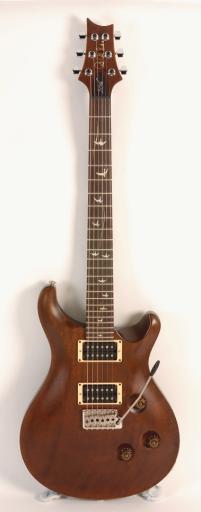MusicRadar Verdict
Even if you own a few PRSes - trust us - you'll have to find the place, and budget, for this Standard 24.
Pros
- +
As Custom, but also the wonderful finish.
Cons
- -
The fact that this isn't a standard model – moon inlays would trim price further.
MusicRadar's got your back
If you've never played a mid-eighties PRS, or indeed any of the hand-crafted guitars Paul and his small team built before 1985, then this Standard will give you an idea of why we're writing about Mr Smith today.
The Standard, now and then, is identical to the Custom save for a one-piece mahogany body instead of the maple/mahogany sandwich of the Custom.
And because the maple top of the Custom is so thick, the all-mahogany Standard not only looks but also sounds profoundly differently from an acoustic standpoint.
The Standard has mirrored the changes of the Custom over the years, although the 22-fret model appeared a year after the Custom 22 in 1994.
Confusingly, in PRS's past there have been maple-topped Standards, but to this writer's mind the Standard is only a Standard if it's all mahogany.
Along with identical 20th Anniversary truss rod cover and bird inlays (the 'board here is Indian rosewood - you only get Brazilian on the Artist Package Custom-only upgrade) this new Standard 24 gets an ultra thin 'matt nitro' finish that we first saw on last year's Modern Eagle.
Here, however, without the maple top of that model it gives the instrument a real utility vibe and our sample's 'vintage mahogany' applies a dark brown stain over the pale natural mahogany.
Want all the hottest music and gear news, reviews, deals, features and more, direct to your inbox? Sign up here.
There's no grain filler so the thin finish reveals much of the mahogany's grain and, because the colour is stained rather than sprayed over a base-coat, the edges especially appear slightly worn or aged.
It's not a robust finish - be warned. It'll ding and mark easily and the matt will soon shine up, especially on the neck back and forearm body area, to achieve a beautiful aged patina.
With just a couple of changes, the 24-fret neck with its smaller heel and regular shape and the new matt finish, the guitar feels so different from our Custom 22.
The regular (or standard) neck profile is only slightly narrower and very slightly thinner in depth, but it still creates a more delicate feel.
The now classic HFS Treble and Vintage Bass pairing is standard (not only on this model but all 24-fret PRSes), and here we have the five-way rotary.
Originally the Standard would have featured the sweet switch instead of a tone control but this was added as standard by late 1991.
Sounds
Lighter in weight, and with a more delicate feel, the Standard just begs to be played. Select the bridge pickup and a crunchy/light-gained amp and you'd swear you were listening to a slightly smoother-sounding double-cut Les Paul Special.
There's that wonderful mahogany Gibbo grind to the mid-range, mirrored by the more open and fluid neck pickup.
The series single-coil sound is sort of hot Strat while the inner and outer single-coil combinations give a couple of flavours of Fender-like funk - the closer spacing of the humbuckers here giving a little more accuracy to the illusion.
There's far less politeness to this Standard compared to the Custom; it's rawer but with astonishing resonance.
It's a more focused sound, less wide than the Custom, but that gives a commanding presence that really cuts through a live band mix.
Not everyone will get on with the five-way rotary switch even though the 513 knobs, with their better grip, make its operation slightly quicker than with a standard knob. All in all, it's an awesome performer.
The real achievement of PRS is quite simply the consistently rising quality of the guitars themselves. There are some who would like us to believe modern PRS guitars are not as good as those made in the early years of the company.
Certainly the early guitars had a charm about them back then, with finish defects, inconsistent shaping, fading colours, vibratos that would quickly wear, noticeable filler around inlays… but 'better' is not a word this writer would use.
The modern PRS guitar is virtually identical but it's built with 20 more years experience and it shows.
Of the 20th Anniversary guitars, the faultless Custom 22 is the more modern instrument; the Standard 24, even more so than the Custom 24, is the 'antique' here.
Guitarist is the longest established UK guitar magazine, offering gear reviews, artist interviews, techniques lessons and loads more, in print, on tablet and on smartphones
Digital: http://bit.ly/GuitaristiOS
If you love guitars, you'll love Guitarist. Find us in print, on Newsstand for iPad, iPhone and other digital readers

